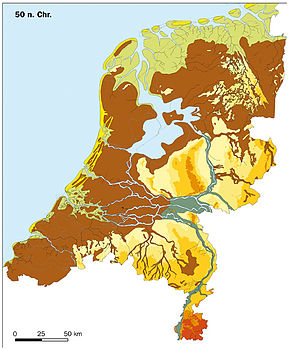Batavia (region)
| (reconstructed) | |

The Netherlands ca 50 AD. The river islands, one of which was Batavia, can be seen slightly below the center. The modern Betuwe region corresponds greatly with the thin island that stretches from the country's center to the German border, and has roughly a third of its western side brown (meaning fens) and two thirds of its eastern side green (meaning river valleys).
|
|
| Alternate name | Betuwe (modern region) |
|---|---|
| Location | Netherlands |
| Region | Gelderland |
| Type | Historical tribal land |
| Part of | Germania |
| History | |
| Cultures | Batavi |
| Satellite of | Roman Empire (after 80 CE) |
| Events | Batavian Revolt |
Batavia was the name used by the Roman Empire for the land of the Batavians, a Germanic tribe. It was described as a large island between rivers in the Rhine-Meuse delta. Its modern equivalent is Betuwe. The Batavians shared the island with the Canninefates, to their west near the coast. Their Roman city was Nijmegen.
The "Batavian island" in the Rhine river was mentioned by Julius Caesar in his commentary Commentarii de Bello Gallico. The island's easternmost point is at a split in the Rhine, one arm being the Waal and the other the Lower Rhine/Old Rhine (hence the Latin name Insula Batavorum, "Island of the Batavi"). Much later Tacitus wrote that they had originally been a tribe of the Chatti, a tribe in Germany never mentioned by Caesar, who were forced by internal dissension to move to their new home.
Tacitus also reports that before their arrival the area had been "an uninhabited district on the extremity of the coast of Gaul, and also of a neighbouring island, surrounded by the ocean in front, and by the river Rhine in the rear and on either side". In a more detailed description he writes:
The name was also mentioned by Pliny the Elder, and it played a role in the account by Tacitus of the Germanic uprising of 68. He said that "In the Rhine itself, nearly 100 miles in length, Batavia is the most famous island of the Batavi and the Canninefates".
Its later Roman history is attested by Ammianus Marcellinus and Zosimus, who described the migrations of the Frankish Salians over the Rhine and into the empire. They first crossed the Rhine during the Roman upheavals and subsequent Germanic breakthrough in 260 AD. After peace had returned, in 297 AD, the Roman Emperor Constantius Chlorus allowed the Salians to settle among the Batavians, where they soon came to dominate the Batavian island in the Rhine delta.
...
Wikipedia
